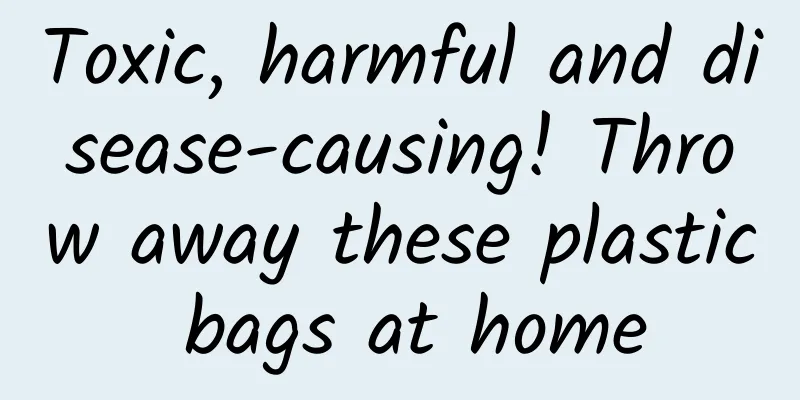Toxic, harmful and disease-causing! Throw away these plastic bags at home

|
Our daily lives seem to be inseparable from plastic products: cups, tableware, straws, take-away boxes, etc. Especially when buying food at the market or supermarket, in order to facilitate weighing, merchants will provide free plastic bags for customers to take. Many people will take a few home after packing, use them to pack vegetables and meat, and wrap food in plastic bags and put them directly in the refrigerator~ Copyright image, no permission to reprint But such behavior is really not advisable - plastics are a large family, some are afraid of heat, some are afraid of oil... using them incorrectly can be very harmful to your health! 1 Supermarket plastic bags are not suitable for storing hot food or meat Plastic bags in regular supermarkets are mostly made of PE material. They are fine for daily necessities at room temperature, but they may not be suitable for fresh food. 1) Only food-grade PE plastic bags can be used to pack food It is important to note that only special "food grade" PE material bags can be used to store fresh food. PE material is a very broad concept. In order to suit different usage scenarios, different additives and production processes are used. This will lead to large differences in residual substances, temperature tolerance, strength, hardness, etc. Therefore, you cannot think that it can be used to store food just because you see the PE logo. Copyright image, no permission to reprint 2) PE plastic bags also have defects The heat resistance is not very strong and it may melt and decompose once the temperature exceeds 80℃. It is not suitable to be in contact with grease for a long time. The raw materials of PE are mainly low-density polyethylene (LDPE) and linear low-density polyethylene (LLDPE). When in contact with grease, the two substances may swell and decompose to a certain extent and dissolve in the grease, making the grease have a rancid smell. Therefore, it is best not to use transparent plastic bags from supermarkets to pack hot food, and do not use them to pack meat and freeze it directly in the refrigerator. It is recommended to use food-grade, well-sealed bags to freeze meat. Copyright image, no permission to reprint 3) Two types of plastic bags that you should avoid putting food in a. Do not use plastic bags that feel soft and do not have the QS mark to pack food, because these plastic bags are afraid of oil and heat. When the temperature of food is too high, harmful substances such as phthalates may be precipitated. Long-term consumption of contaminated food will increase the risk of high blood sugar and high blood lipids. b. Colored plastic bags are unhealthy because they may contain "toxic and harmful" ingredients - benzopyrene. In particular, black plastic bags that are often used to pack seafood are actually recyclable plastics. Therefore, do not use colored plastic bags to pack food that is eaten directly. Copyright image, no permission to reprint Plastics have different properties due to different colorants, plasticizers, stabilizers, and fillers. So how should we use plastic products such as lunch boxes and plastic bottles correctly? 2 Don’t heat plastic lunch boxes blindly There are 4 more things to note 1) Only PP material can be heated There are three standards for plastic lunch boxes: 1 (PET), 5 (PP), and 6 (PS) - the heat resistance of PET is only 70°C, the heat resistance of PS is only 90°C, and the heat resistance of PP material reaches 130°C, and the melting point is as high as 200°C. Therefore, generally only plastic made of No. 5 PP material can be heated in a microwave oven. 2) Precautions for using plastic lunch boxes a. Remove the lid of the lunch box when heating Some microwave lunch boxes are made of PP No. 5, but the lid is made of PE No. 4, and PE cannot withstand high temperatures. So remember to remove the lid before putting it in the microwave. b.Replace in time The service life of lunch boxes is generally 3-5 years, but if they change color, become brittle or yellow, they should be replaced immediately. c. Clean thoroughly Some lunch boxes have sealing rings on their lids to ensure tightness, but food residues seep into the sealing rings, which become a breeding ground for mold. It is recommended to clean the sealing ring and its groove every time you clean it, let it dry, and then put it back on the lid. Copyright image, no permission to reprint d. Do not store food that will accelerate the aging of the lunch box If alcohol, carbonated drinks, vinegar and other acidic substances are stored in the lunch box for a long time, it is easy to accelerate aging. Therefore, if you have homemade vinegar-soaked peanuts, bayberry wine, etc., remember not to put them in plastic fresh-keeping boxes, you might as well replace them with glass containers for storage. 3) Disposable plastic takeaway boxes are not recommended to be reused Nowadays, many takeout boxes appear to be of good quality and are marked with the relatively safe No. 5 PP material. Some people cannot help but wash them and store them at home for reuse. But this is actually wrong. For reasons such as cost control, disposable lunch boxes usually do not have very high safety standards. They are made for the purpose of holding one-time, high-temperature, and oily food. Under this condition, it is safe to use. However, if it is used more frequently, its stability will be destroyed, and harmful substances will be precipitated, which may affect health in the long run. Copyright image, no permission to reprint 3 Plastic bottles for beverages Can it be used to store sauce, vinegar, and oil? Nowadays, many beverage bottles look good and are sturdy, so it would be a pity to throw them away. Many people will wash them after drinking, and keep them to hold water or some beans, whole grains, soy sauce, vinegar, oil, or even pickled vegetables, but are these methods appropriate? Copyright image, no permission to reprint It is best to throw away plastic bottles for beverages after drinking: Poor heat resistance Plastic bottles containing mineral water, juice, and carbonated drinks usually have "1" written on the bottom. Plastic No. 1 is polyethylene terephthalate (PET). This material has poor heat resistance and the maximum operating temperature does not exceed 70°C. It is easy to deform when heated or filled with boiling water, and harmful substances will also dissolve. When it comes into contact with oil, grease, acid or alkali, harmful substances are easily precipitated There are clear studies showing that when oil is packed in PET plastic bottles at the same temperature, the amount of phthalates (a type of plasticizer) migrated is nearly 20 times more than when water is packed in PET plastic bottles! In addition, the pH value of vinegar is relatively low. Most PET plastic beverage bottles may use the metal catalyst "antimony" in the production, and the migration rate of harmful substances in acidic and alkaline environments will increase. The more times it is reused, the higher the probability of releasing carcinogens Studies have found that No. 1 plastic will release the carcinogen DEHP after 10 months of use, and the more times it is reused, the higher the probability of releasing carcinogens and the more bacteria will grow. So, throw away the beverage bottle after drinking it. 4 2 key points for safe use of plastic products 1) Look at the logo: Plastic products are usually marked with numbers from 1 to 7. These numbers include some safety tips: No. 1 plastic is commonly used to make mineral water bottles and carbonated beverage bottles. It cannot be used to hold hot water and should not be reused. No. 2 plastic is mostly used to make containers for cleaning supplies and bath products. It has a high density, is very strong, and can be reused. No. 3 plastic is commonly used to make raincoats, garbage bags, plastic greenhouses, rubber pipes, etc. It has good performance, wear resistance and acid resistance, but it is not heat-resistant and highly toxic. No. 4 plastic is commonly used to produce plastic wrap, plastic film and other materials. It is breathable but not water-permeable and has low heat resistance. No. 5 plastic is commonly used to make plastic cups and plastic lunch boxes. It can be used to store food and heat in a microwave. No. 6 plastic is commonly used in the production of instant noodle boxes and fast food boxes. It is heat-resistant (heat-resistant 60-70℃) and cold-resistant, but cannot be put into the microwave and cannot be used to hold strong acids or alkaline substances. No. 7 plastic is mostly used to make baby bottles, space cups, etc. It is not suitable for storing boiling water. 2) Read the instructions Many big brands will mark the instructions for use on the product packaging. Don't be bothered, be sure to read every one of them carefully, such as what is the applicable temperature, whether it can be put in the microwave or refrigerator, etc. Finally, it is still recommended that everyone reduce the use of plastic products, and it is recommended that everyone use cloth bags, paper bags, porcelain or glass products, which can protect the environment and is good for your health! Source: I am a great doctor official account The cover image of this article is from the copyright gallery, and the image content is not authorized for reproduction |
>>: Why should you be careful of large livestock when driving to pastoral areas?
Recommend
Musee d'Orsay: a concerto between technology and art
The Musée d'Orsay, which has been open to the...
Among the 250,000 yuan pure electric sedans, which one is more cost-effective, the Huawei Zhijie S7 or the Xiaopeng P7i?
Speaking of the most popular pure electric sedan ...
How to do Tik Tok marketing?
During this period, Tik Tok is very popular and e...
Domestic phones have no screens available, Samsung OLED will only be enough for Apple next year
As the growth of the global smartphone market cont...
The traffic dividend has disappeared, where is the way out for the promotion of small and medium-sized apps?
The truth behind the disappearance of traffic div...
How to get started with user operations in 4 steps?
I believe that those who are engaged in operation...
It is green, but why is it so hard to see trees on the grassland?
Author: Duan Yuechu and Huang Yanhong When we ste...
What! We won't be able to drink Coke in half a year?
On a hot summer day, opening a bottle of ice-cold...
New discovery | Intestinal flora affects obesity!
Obesity is a global public health issue. Some stu...
Lithuanian officials urge citizens to throw away Chinese mobile phones
Lithuanian politicians have jumped out again to a...
Community Operation Growth Flywheel
We can start from the five major links of the com...
How much does bidding hosting usually cost per month? How to do bidding hosting?
Many clients don’t quite understand these issues....
China Association of Automobile Manufacturers: A brief analysis of the sales of the top ten SUV manufacturers in January-February 2023
According to statistics and analysis by the China...
Many people dream of traveling through time. After watching the conflicting film "The Tomorrow War," you'll know how absurd it is.
The so-called time travel is to travel from one t...
User blindness phenomenon: 50% of traffic is wasted!
Although our eyes perceive everything, only a sma...









